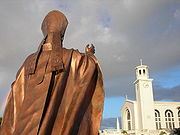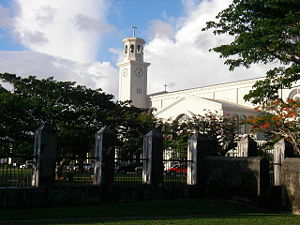
Dulce Nombre de Maria Cathedral Basilica
Encyclopedia


Guam
Guam is an organized, unincorporated territory of the United States located in the western Pacific Ocean. It is one of five U.S. territories with an established civilian government. Guam is listed as one of 16 Non-Self-Governing Territories by the Special Committee on Decolonization of the United...
was constructed in 1669 under the guidance of Padre San Vitores
Diego Luis de San Vitores
Blessed Diego Luis de San Vitores was a Spanish Jesuit missionary who founded the first Catholic church on the island of Guam. He is responsible for establishing the Spanish presence in the Mariana Islands.-Early life:...
. The present building looms above the palm trees and is a familiar landmark in downtown Hagåtña, Guam
Hagåtña, Guam
Hagåtña , formerly English Agana and in Spanish Agaña, is the capital of the United States island territory of Guam. It is the island's second smallest village in both area and population. From the 18th through mid 20th century, it was Guam's population center...
.
History
The precursor of the present day Basilica was a chapel, or capilla, constructed of rough logs and nipa thatch built within the perimeter of the Plaza de España. The Church was the focal site around which the administrative buildings were built. Built under the direction of Padre Diego Luis de San Vitores, with the assistance of the Chamorus of Hagåtña, it was dedicated on February 2, 1669. Queen Maria Ana donated 300 pesos and Chief Kipuha of Hagåtña contributed the land. In 1670 a more permanent structure was erected. Built of coral stones with the technique of mamposteria, this structural foundation expanded to become the Cathedral. Within this structure were walls, ceilings and floors constructed of ifil wood. A fresco on the rear wall depicted the Assumption of the Blessed Virgin Mary. The original Cathedral was destroyed by bombardment during the retaking of Guam.According to historian Benigno Palomo, in 1669, one of the main mission of the Spanish soldiers and missionaries was to exalt "the Catholic faith" and that "the people living in islands and land of this sort, you will and ought to bring to the Christian religion", from the Bill of Partition issued by Pope Alexander VI
Pope Alexander VI
Pope Alexander VI , born Roderic Llançol i Borja was Pope from 1492 until his death on 18 August 1503. He is one of the most controversial of the Renaissance popes, and his Italianized surname—Borgia—became a byword for the debased standards of the Papacy of that era, most notoriously the Banquet...
.
Other churches were built at Funa near Umatac, at Tepungan by Asan, at Ritidian, at Tarrague, at Dededo and at Orote. Initially, many of these churches were destroyed by the Chamorros in their effort to regain their independence. Others were destroyed by natural causes. Over the years, the Chamorros gradually accepted the faith of the Spanish as their own.
As time passed, village life centered around the church. Rituals involving birth, transition from adolescent to manhood, marriage and death centered around the church.
Before the war there were nine churches and 22 chapels throughout Guam. These chapels were little sanctuaries between villages where one could privately pray during the long journey to and from home. All were destroyed during World War II
World War II
World War II, or the Second World War , was a global conflict lasting from 1939 to 1945, involving most of the world's nations—including all of the great powers—eventually forming two opposing military alliances: the Allies and the Axis...
except San Dionisio at Umatac, San Jose at Inarajan and San Francisco at Yona.
Today
The Cathedral-Basilica's existing structure has reached its golden age of 50 years after being constructed and dedicated on April 20, 1959. Today, the Cathedral-Basilica serves as local landmark and is home to a community of parishioners who regularly attend Sunday Masses, sacred liturgies and annual events. It is also a place where Guam's visitors embrace the island's rich Catholic history and identity.On the grounds of the Cathedral-Basilica, visitors will find the Basilica Cafe and the Cathedral-Basilica Gift Shop. The cafe serves hot Caribbean lunches and offers a menu full of delicious hot or iced coffee drinks, exotic teas, shakes and fruit smoothies. You can also stop by the cafe for freshly baked homemade cookies, breads and Caribbean snacks.

